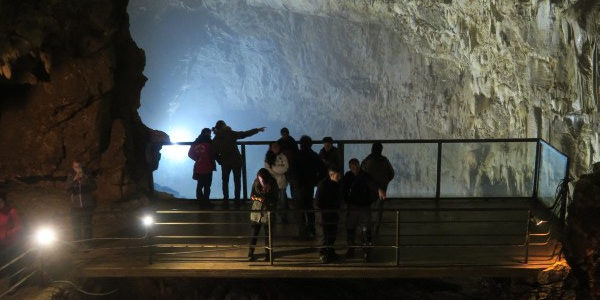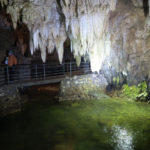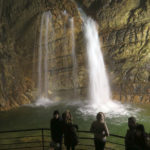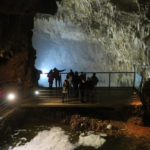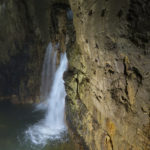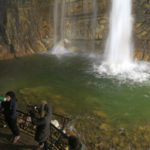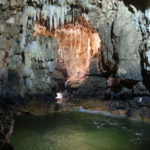THE STIFFE CAVE
(San Demetrio de’ Vestini – AQ)
Opened in 1990 this show cave, definitely the most important of the Abruzzo region, is a large active spring from where the underground water comes out from Pozzo Caldaio, a large sinkhole dominated by the town of Rocca di Mezzo, the main town of a vast plateau particularly rich with karst phenomena where there are the municipalities of Rocca di Cambio and Ovindoli.
The entrance, eight metres high and four metres wide, goes into a tunnel going slightly uphill, winding at the start then straight, where an underground river always flows through whose capacity is strictly tied to rainfall and the melting snow which during Winter is abundant all over the massif of the Velino-Sirente. On the ceiling without formations in the first part types of phreatic erosion can be seen, corresponding to an evolutionary phase characterized by the total submersion of the passage.
Further on the tunnel takes the shape of a large gorge and here and the first formations appear. The large Chamber of Silence follows, where in periods of drought the river flows along a thick layer of debris, and past a narrower part an impressive flowstone is passed and an immense chamber is entered from where a waterfall of almost twenty metres precipitates into a big underground lake.
The rock face where the waterfall flows is a magnificent mirror of a fault line which cuts obliquely the tunnel. A staircase goes up a large man made tunnel which leads to the top of the waterfall, where a little pool precedes a second waterfall of five metres. Proceeding in a succession of pretty pools, the formations, mostly covered by a veil of water and still growing, increase in number and get more beautiful. The tour, lasting about an hour, ends in a room where another waterfall of twenty metres, also caused by a fault, precipitates loudly into a deep pool.
The walkway, built in anti-slip cement with some parts in steel grids, has been made carefully. It is elegant and practical and blends in well the the natural environment.
Some observations however can be made about the lighting, which does not fully enhance some of the morphological aspects and does not emphasize the beauty of the formations in full.
The water from the river shows evident signs of pollution (mostly foam), perhaps due to the anthropization of the Plateau of the Rocche.


